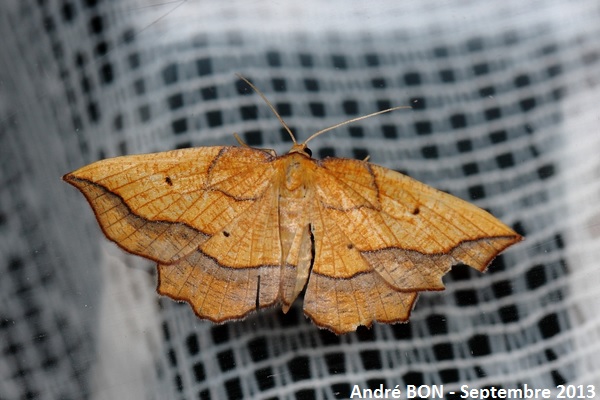
| Bordered Beauty (Epione repandaria (Hufnagel, 1767)) |

|
|
Scientific name: Epione repandaria (Hufnagel, 1767) Common name: Bordered Beauty French name: Epione marginée, Epione des saules. Order: Lepidoptera Suborder: Heterocera Family: Geometridae Subfamily: Ennominae Wingspan: 26-30 mm. Biotope: Damp places, forests, lake shores and river banks where the host plants grow. Geographic area: Europe from northern Scandinavia south to the north of the Mediterranean regions, Asia east to Siberia. Flight time: June-July then September-October. Number of generations : 2 (only 1 on the northern part of the range). Caterpillar: Black on the upper side and cream-coloured on the underside. The first segments are marked by two thin whitish subdorsal lines. The following ones bears weakly marked pale dorsal spots. Host plant: Mainly on Willows (Salix) but also on Poplars (Populus), Alders (Alnus) and Blackthorns (Prunus spinosa). |
The Bordered Beauty has yellow wings powdered with orange dots. Veins are also orange-coloured. The fore wings are marked with a blackish brown antemedial line drawing a right angle on the middle of the wing. You can see a postmedial line connecting the inner edge to the apex of the wing. The delimited terminal area is a more greyish colour especially close to the postmedial line. There is small black discal spot. The hind wings are similar to the fore wings except that they are missing the antemedial line and that the postmedial line does not reach the apex of the wing but the costal edge at about two third of its length. Males have bipectinate antennae while females have thread-like antennae. The Bordered Beauty is attracted to light. It over winters at the egg state. The Dark Bordered Beauty (Epione vespertaria), which is more a mountain species, is recognized by its more wavy postmedial line not ending at the apex of the wing on males. The colour of the terminal area is more dark brown to violet. |
| [To know more about the Bordered Beauty] [Top] |

|
This Bordered Beauty came to land on the window, attracted to light. |